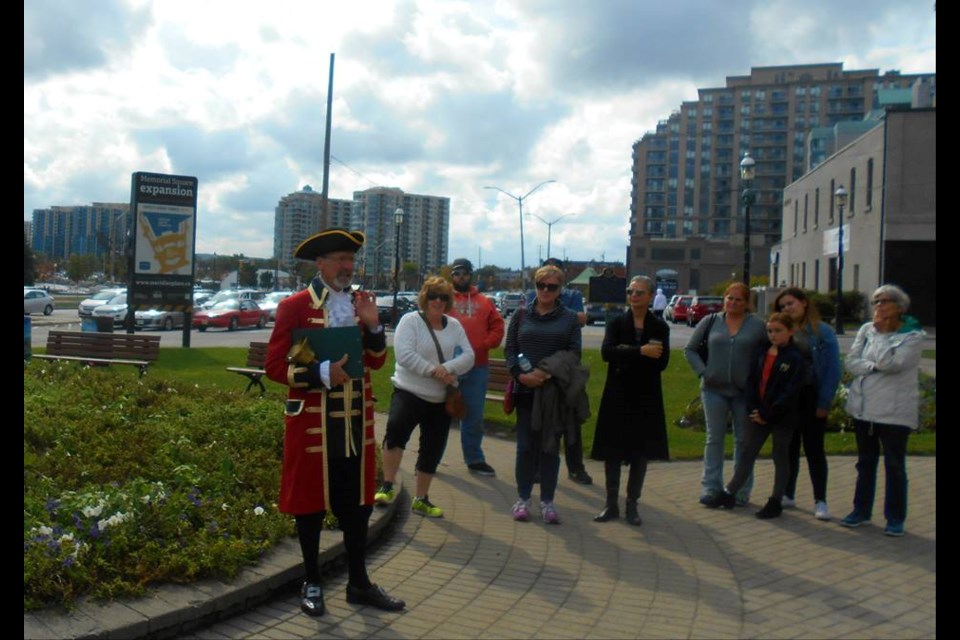Fittingly, our walking tour began on a very pivotal piece of ground. Memorial Square, as it is now known, is a passive park today, largely grass and well manicured gardens, park benches and the cenotaph honouring lost Barrie boys. It was once a hub of Downtown activity, and may be so again very soon, only in a very different way from its origins. We stood there, one foot in the past and one in the future, remembering the magnificent post office and the Barrie train station who were here, as Town Crier Steve Travers began his talk. Over his shoulder, a large sign promoting big changes and a new name, Meridian Place, observed us in silence.
Steve gave us a condensed history of how this city came to be, how a few smart settlers on the shores of Kempenfelt Bay took up what the First Nations people had begun, first bringing goods through the woods along the Nine Mile Portage and then creating a central market town that still thrives today. When the population of Barrie was only 50 souls, there were already three taverns operating. These few citizens were certainly not the only ones keeping the pubs afloat. It was the farmers, traders and lumbermen who regularly came into Barrie to sell their goods.
First, we walked west along Dunlop Street and stopped at the famed Five Points intersection. I call it Three Points as two of its corners have been lost to fire in recent years, but that too is about to change. Steve had us look towards the Simcoe Hotel, the historic epicentre of drink fueled hijinks and infamy in the Downtown area. It is said that Sir. John A. McDonald was not keen on his mother-in-law, who lived in Barrie for a time, so he would spend the night at the Simcoe and drink with the local ruffians rather than suffer the company of Mrs. Theodora Bernard.
We were informed about the lives of some of the local ladies who, as Steve put it, “worked very, very late at night.” One such businesswoman was Mary ‘Scoot’ Hodgins, who in June of 1875 was targeted by a crowd of upstanding church folks who had enough of the shady ladies of Barrie and decided to pay her a visit at her home. Mary came outside and listened as one of the more saintly citizens stood on a box and preached to the like-minded others about how this kind of behavior must be stamped out. After the sermon, Mary approached the crowd and greeted some of the ones that she knew especially well, then she went to the speaker and whispered something to him. Then she bit off his ear! I believe they left Mary alone after that.
A while later, we found ourselves on the corner of Mulcaster and Worsley Streets, looking up at the old Barrie Jail. I was inside the building only once, long after it closed, but got a bit spooked and ran out before I could really explore it properly. I really do hope someone makes some good use out of it some day as it is one of the oldest (if not the oldest) jails in Ontario and has a very unique octagonal design. The walled in yard contains numerous burials, the one mentioned on our tour was of the man who was hanged for murder but killed again after he was dead! Yes, indeed, he was hanged on a summer day and the coroner booked to do his mandatory autopsy took quite a while to get himself to Barrie, possibly a week. The doctor nicked his finger while examining the overripe corpse and died a week later from blood poisoning!
Aptly entitled Heroes, Harlots, Saints and Sinners, this walking tour with the Town Crier blends fascinating historical fact with the satisfying allure of an old-time penny dreadful. Heritage Barrie sponsors these wonderful walks. Do not miss the next one!



